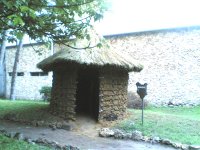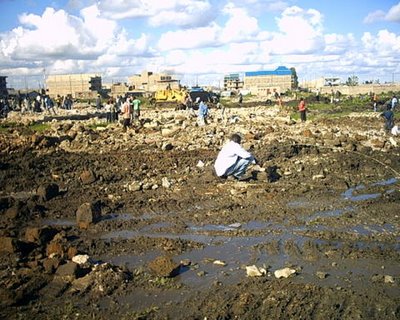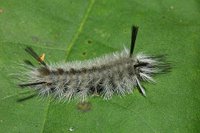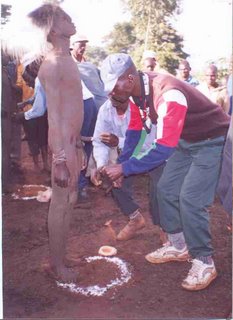nnnnnnnnnnnn TOP nnnnnnnnnnnnnBukusu Culture, Babukusu
***** Location: Kenya
***** Season: Non-seasonal Topic
***** Category: Humanity *****************************
Explanation
The Bukusu culture is under erosion by many other cultures.
Let us try and write some haiku about it.
Patrick Wafula, September 2006
xxxxxxxxxxxxxxxxxxxxxxxxxxxxx
© From Wikipedia, the free encyclopedia
Bukusu peopleThe Bukusu are one of the seventeen Kenyan sub-tribes of the
Luhya Bantu language and cultural group of East Africa. Calling themselves 'BaBukusu', they are the largest single ethnic unit among the Luhya nation, making up about 17% of the whole Luhya population. The other Luhya groups in Kenya are ABaTiriki, Maragoli, ABaNyore, ABaKhayo, ABaMateka, ABaNyala, ABaSamia, ABiSukha, AbiTakho, ABaShisa, ABaMarachi, ABaTsotso, ABaKabarasi, ABaTachoni, ABaWanga and ABaMarama.
OriginsThe Bukusu myths of origin state that the first man, Mwambu( The discoverer or inventor), was made from mud by Wele Khakaba at a place called Mumbo (which translates to 'West'). God then created a wife for Mwambu, a woman called Sela. Mwambu and his descendants moved out of Mumbo and settled on the foothills of Mount Elgon, from where their descendants grew to form the current Bukusu population. Other traditional stories relate of a plac of origin called Misri, from Mizraim (Hebrew for Egypt) Anthropologists believe that the Bukusu did not become a distinct grouping apart from the rest of the Luhya population until, at the very earliest, the late 18th Century. They moved into Central Uganda as part of a much larger group of people, many forming the eastern extension of the great Bantu migration out of central Africa. (See Origins of the Luhya.)
SettlementTogether with other Luhya groups, the Bukusu are thought to have first settled around the foothills of Mount Elgon. This area was already inhabited by Kalenjin warrior tribes, and the Bukusu and their neighbours had to build fortified villages to ward off the attacks of these tribes. The first fortified villages were built at a place called Silikwa (sometimes called Sirikwa). Following repeated attacks and unfavourable weather conditions, folklore has it, a council was held at Silikwa and it was resolved to migrate south and east, where spies are said to have reported large, unsettled lands. However, a section of the population was reluctant to move and stayed behind when the main tribe moved.
Those who stayed behind are said to have become the Ugandan BaMasaaba tribe. Those who left moved into what is now Bungoma district of Kenya, to become the ancestors of the current Bukusu people. Currently, the Bukusu mainly inhabit Bungoma district of Western Province, which is bordered by Kakamega District to the east, Busia District to the south, Mount Elgon to the north and Uganda to the west. A large number of the Bukusu are also found in the Kitale area of Kenya's Rift Valley province, as well as in Lugari-Malava district. The BaMasaaba of Uganda are very closely related to the Bukusu, with many shared customs and a common dialect of the Luhya language.
Previously, the Bukusu were referred to as the
'Kitosh' by the neighbouring Kalenjin community, a name they despised. The reasons for this are not very clear: in some Kalenjin dialects, "Kitosh" means "people of the earth". This could have been a reference to the agricultural Bukusu, or to the fact that they lived on the lower foothills of Mount Elgon. Following vigorous campaigns by community elders, the name Kitosh was eventually substituted with Bukusu in the mid 1950s.
 A replica of a Bukusu hut at the Sarova White Sands Hotel in Mombasa, Kenya.Traditional life
A replica of a Bukusu hut at the Sarova White Sands Hotel in Mombasa, Kenya.Traditional lifeThe Bukusu lived in fortified villages, and did not have a structure of central authority. The highest authority was the village headman, called Omukasa, who was usually elected by the men of the village. There were also healers and prophets who acquired great status because of their knowledge of tribal tradition, medicines, and religion. Elijah Masinde, a resistance leader and traditional medicineman, was revered as a healer in the early 1980s.
FamilyBukusu family structure was traditionally modelled on the generic Luhya family structure. Families were usually polygamous, with the first wife accorded a special status among her co-wives. Society was entirely patrilineal: women were present only as child-bearers and as an indication of status. In addition, being polygamous meant more hands to work the fields, which was an advantage in a society founded on agriculture.
Children inherited the clan of their father, and were not allowed to marry spouses from either their own clan, or their mother's clan. The first son of the first wife was usually the main heir to his father, and he had a special name denoting this status: Simakulu. At birth, children were usually named after grandparents or famous people, or after the weather. Male and female names were different: male names frequently began with 'W', while female names usually began with 'N'. Thus, for example, a boy born during a famine would be named 'Wanjala', while a girl would be named 'Nanjala'. Both names share the same root word, 'njala', from 'eNjala', the Bukusu word for hunger.
InitiationThe Bukusu practised (and still practise)
male circumcision. It is thought that they adopted the practice from contact with the Kalenjin at Mount Elgon. Others argue, however, that the presence of the practice in the other Luhya tribes indicates an earlier adoption, before the Bukusu settled at Mount Elgon. In ceremonies that were spaced about two years apart, young boys of a particular age (usually about 15 years of age) would, on getting the go-ahead from their parents, invite relatives and friends to their initiation.
The initiation was a public event, witnessed by all. Going through the operation without showing any sign of pain was (and still is) thought to be an indicator of bravery. Once circumcised, an initiate became a member of an age-group. There are twelve age-groups, forming a cyclical system, with each age-group lasting for 8 years. Once the last age-group has been reached, the first is restarted, and so on. For example, the "Bachuma" age-group lasted from 1980 to 1986: every Bukusu circumcised within this period (that is, in 1980, 1982, 1984, and 1986) belongs to that age-group. In 1988, the "Basawe" age group began, and lasted until 1994.
Female circumcision (clitoridectomy) was widely practiced among the Bukusu, until government campaigns put an end to the practice in the 1980s. However, some clans still continue the practice in secret. This is especially the case around Mount Elgon, where the neghbouring Kalenjin tribes also practice a form of female circumcision. Although circumcision was universal among the Bukusu, the form of the ceremony varied according to the clan. In particular, the festivities and ceremonies accompanying the final stage of initiation, when the now-healed initiates came out of seclusion to rejoin their families as 'men', were specific to clans, and have been handed down largely intact to the present day.
MarriageYoung men got married at about the age of 18-20, while girls got married at about the age of 16. There were two types of first-time marriage: arranged marriages and enforced eloping. If a young man came from a well-to-do family, he would ask his sisters to find a girl for him to marry. The ability of a potential wife to cook well, bear children and work in the fields were the main attractions in a girl. Once a girl was identified, an emissary was sent to her parents to ask for her hand. The girl had no say whatsoever in the whole matter: bride price would be discussed, and then once it was paid she would be sent off to live with her new husband. This form of marriage is still common in traditional households today.
In some cases, however, the young man would be from a poor family and could not afford to pay the likely bride-price. Traditional society allowed such young men to abduct the girls they intended to marry. (The girl had to present an opportunity to be 'abducted', so her cooperation was essential!) The couple would then leave their home to live with a far-off relative for a while, until the young man acquired enough wealth to pay the original bride price, as well as a fine, to the parents of the girl. This practice has since died out.
The Bukusu highly approve of intermarriages between themselves and BaMasaaba. This is because they have quite a number of similarities in their codes of conduct, marriage customs, circumcision traditions and even folklore. Among the most famous of Bukusu marriage customs is the immense respect accorded one's in-laws. A lady, for example, treats her father-in-law with a lot of deference and respect, and they are not allowed to make physical contact in any way. The same is true of a man and his mother-in-law.
In a marriage, duties were strictly segregated. Housework and agricultural duties were done by the women and the children. The older boys looked after cattle. Young, newly married men formed the community's warriors, while middle-aged men did nothing, mainly. Older men formed the village's council of elders, and resolved disputes. Punishment for crimes was usually on an-eye-for-an-eye basis, while petty crimes like theft were punished by the perperators being expelled from the village, and their property confiscated and redistributed to the wronged party.
Cattle were very important: they were the main means of exchange, alongside cowrie shells (chisimbi). Most values, from the beauty of a girl to the price of a field of land, were expressed in terms of head of cattle. Possessing cattle wealth and prosperous agriculture, the Bukusu were sometimes not only admired but also envied by neighboring communities.
Occasionally intermarriages used to take place between them and the other communities. It was common practice for Kalenjin neighbors to give Bukusu their sons to look after their herds of cattle. In times of famine, which are said to have been frequent amongst their Kalenjin neighbors, the latter used to even sell their children to Bukusu. Bukusu also used to send their own young boys to grow up with Kalenjin or Maasai families, in some cases for espionage purposes.
Death
Being sedentary pastoralists, they had time to care for their sick and bury their dead. A sick person was looked after till he recuperated or died. When a person died, he was buried in a grave with a warrior’s weapons if he was an elder. Several functions were performed during and after the funeral ceremony. Ordinarily, burial pits ranged from 3-4 feet in depth, much shallower than today’s. Sometimes wild animals like hyenas exhumed corpses from graves and ate them. Should such an incident occur, people looked for the presumed skull of the desecrated body, and when they found it, they hung it in a leafy tree.
When the family of the deceased migrated, they brewed beer (kamalwa ke khuukhalanga) for the ceremony of transferring the skull with them to the new home or settlement. An old woman was entrusted with the responsibility of conveying the skull to the new site. Burial of the dead was thus, to say the least, ingrained in the Bukusu traditions.
Economic activitiesBukusu accounts indicate that both agricultural and pastoral economies have been practiced by the tribe for as long can be remembered. This is authenticated by the vast amount of knowledge they have about farming practices, rich pastoral vocabulary and the broad variety of legends connected with pastoral life. Today, they farm mainly maize for subsistence and sugar cane as a cash crop in the Bungoma area, as well as wheat in the Kitale area. Cattle and sheep are universally kept, cattle mainly for milk, and sheep for meat and ceremonial functions (when a sheep usually has to be offered to elders for sacrifice). Larger or polygamous families will usually have a team of oxen for ploughing and hauliage within the home. Chicken, a traditional delicacy, are nowadays reared on small to medium scales for commercial egg production.
PoliticsThe Bukusu currently form one of the main support bases of the governing coalition in Kenya, through the Ford-Kenya political party. Previously, they were mainly associated with opposition to the Kalenjin-dominated reign of former President Daniel Arap Moi.
Notable Personalities
Among the more notable Bukusu personalities past and present:
Maina wa Nalukale, a seer who was reputed to have foretold the coming of the British colonialists
Elijah Masinde, resistance and religious leader
Michael Wamalwa Kijana, former vice president of Kenya
Masinde Muliro, former minister and opposition leader
Musikari Kombo, current leader of Ford Kenya
ReferencesAyot, Henry Okello (1977) History Texts of the Lake Region of East Africa. Nairobi, Kenya: Kenya Literature Bureau.
Barker, Eric E. (1975) The Short History of Nyanza. Nairobi, Kenya: East African Literature Bureau.
Makila, F. E. (1978) An Outline History of Babukusu of Western Kenya. Nairobi, Kenya: Kenya Literature Bureau.
Were, Gideon S. (1967) A History of the Abaluyia of Western Kenya: c. 1500-1930. Nairobi, Kenya: East African Publishing House.
© The Wikipedia xxxxxxxxxxxxxxxxxxxxxxxxxxxxx
Elija Masinde (also spelt Elijah Masinde) was a traditional leader of the Bukusu people of western Kenya.
Early life
Born around 1910 - 1912 in Bungoma district, Masinde started out as a footballer, going on to play for Kenya against Uganda in 1930. By the early 1940s, he had risen to the rank of a junior elder within his community in Kimilili area, and became increasingly anti-colonial. In 1944, he led a number of localised defiance campaigns against the colonial authorities, and was imprisoned as a result.
Dini Ya MusambwaWhile in jail, Masinde claimed to have been given divine interpretation of the Old Testament of the Bible, and proclaimed that a "Black Jesus" would come to liberate the people of Kenya from colonial oppression. When he was released, he formed a sect called "Dini Ya Musambwa" (Bukusu for "Sect of the Spirit"), and gained huge followings in western Kenya.
Detention, old age, and death
Upon Kenya's independence, Masinde was detained by the government of Jomo Kenyatta for almost 15 years. He had been accused of formenting religious hatred. He was released by the government of Daniel Arap Moi in 1978, and lived quietly in his native Kimilili area until his death in 1987.
It is reported that, before his death, Masinde pointed out to his family the spot where he wanted to be buried - he wanted a huge sycamore tree uprooted to make way for his grave. The family decided to bury him elsewhere, though, but were thwarted when a spot they chose for his grave turned out to be a hidden grave. They took this to be an omen and proceeded to bury him in the spot where the sycamore tree had been.
References
*Makila, F. E. (1978) An Outline History of Babukusu of Western Kenya. Nairobi, Kenya: Kenya Literature Bureau.
*Alembi, Ezekiel. (2000) Elijah Masinde: Rebel with a cause''. Nairobi, Kenya: Sasa Sema Publications Ltd.
http://experts.about.com/e/e/el/Elija_Masinde.htm:::::::::::::::::::::::::::::::::::::::::::::::::::::::::::::::::::::::::::::::::::::::::::::::::::::
 The clashes of the early 90s in Mount Elgon, between the Sabaot and the neighbouring Bukusu
The clashes of the early 90s in Mount Elgon, between the Sabaot and the neighbouring Bukusu, is much discussed.
Tension between the two goes back a long way; several narrators talk of incidents in 1963, and others make it clear that taking part in continuing raids on the cattle of these and other ethnic groups was almost a point of honour: "there was insecurity, but this is something we were used to from childhood. We always had our weapons ready for any eventuality, and especially the warrior group, which was prepared to defend the community at anytime.. It was always very honourable to bring home livestock from a raid, because this emphasised the fact that you were a brave and courageous man." (Joseph, M/86, Kenya 13)
The fighting between Bukusu and Sabaot in the early 1990s, however, was of a slightly different nature. Other socio-ethnic groups, such as the Teso, were also involved, but there has been some debate over how accurate it is to call them 'tribal' or 'ethnic' clashes. Many feel that their real cause was political and economic. Several narrators state that multi-party politics have exacerbated, even exploited traditional rivalries. One farmer believes land shortage to be the root of the problem and certainly many Sabaot feel that the Bukusu have over the years taken their land and forced them on to the more marginal areas they now occupy. This is why many Sabaot want to clear the area of all but Sabaot.
Other scores were settled too - one man felt that he was a target during the clashes because of a personal vendetta. Yet despite the recognition of contributory factors, most narrators - who are all Sabaot bar one - feel that ultimately the clashes stemmed from the long-term oppression of the Sabaot by the Bukusu: "Bukusu are very proud people who have always looked down upon the Sabaot....the clashes that occurred recently were our way of resisting the domination of the Bukusu."
The effects of the clashes were far reaching. Development is often perceived to have stagnated since then, and schooling has suffered too: many teachers were Bukusu, who fled during the fighting and haven't returned. Several women felt they were the most adversely affected because many had intermarried with other tribes and so they were hit "on both sides". "We are hurt as women because we gain nothing. Women have no boundaries, we have no tribal boundaries" (Kenya 5) .
However much the Sabaot believe that the conflict of the 1990s was justified, many also acknowledge that the impact has been negative on all concerned. There are several stories of personal tragedy, particularly from those who lost their homes and became refugees as a result. One Teso narrator talks of the aftermath of the clashes: "I...did not want to come back, for I had lost everything that I had. I do not have the energy to go back and till the land, but the government appealed to us to come back...to regain my wealth is impossible" (Silbabel, M/90s, Kenya 17).
Interestingly, despite the strong desire to separate themselves from other groups, especially the Bukusu, several Sabaot narrators point out that it was from the Bukusu and Teso that they learned useful agricultural practices and about the value of education. And several women narrators say that not mixing with other groups can cause underdevelopment as well, because without ethnic diversity, people lack exposure to different ideas and innovations.
http://www.mountainvoices.org/k_th_conflict.asp:::::::::::::::::::::::::::::::::::::::::::::::::::::::::::::::::::::::::::::::::::::::::::::::::::::
Proverbs What is in the stomach carries what is in the head.
A child (young person) does not fear treading on dangerous ground until he or she gets hurt (stumbles).
http://www.afritopic.com/afritopic-proverbs.htm ***************************** Worldwide use*****************************
Things found on the way*****************************
HAIKUa young Bukusu
circumcisee smeared with mud --
circumcision rite
© Patrick Wafula, 2006
Read more about the Bukusu Circumcision
as a kigo for the cool dry season here. xxxxxxxxxxxxxxxxxxxxxxxxxxxxx
*****************************Related words*****
Bukusu Initiation / Circumcision *****************************THE KENYA SAIJIKI
Please send your contributions to Gabi Greve / Isabelle Prondzynski
worldkigo .....Back to the Worldkigo Index




























